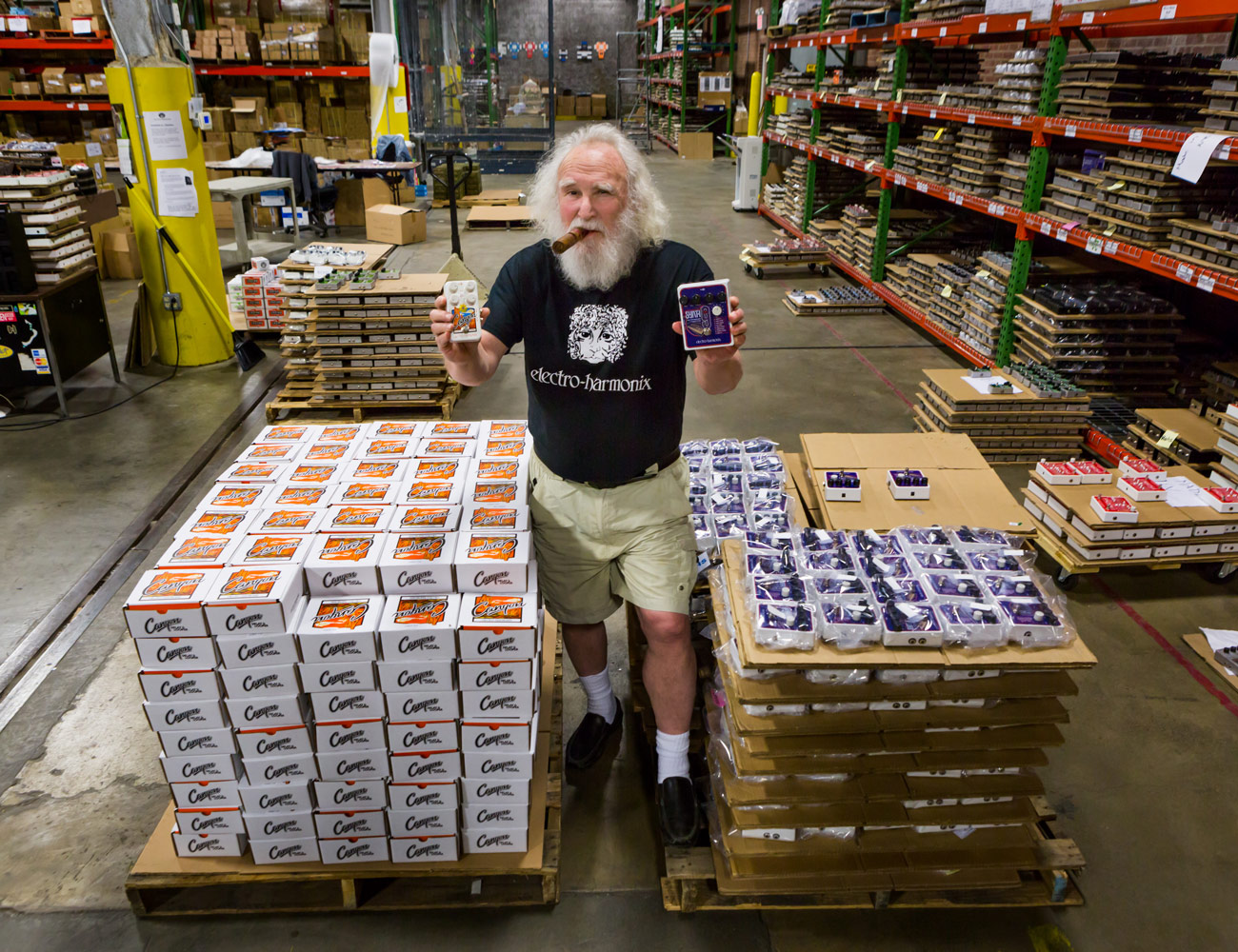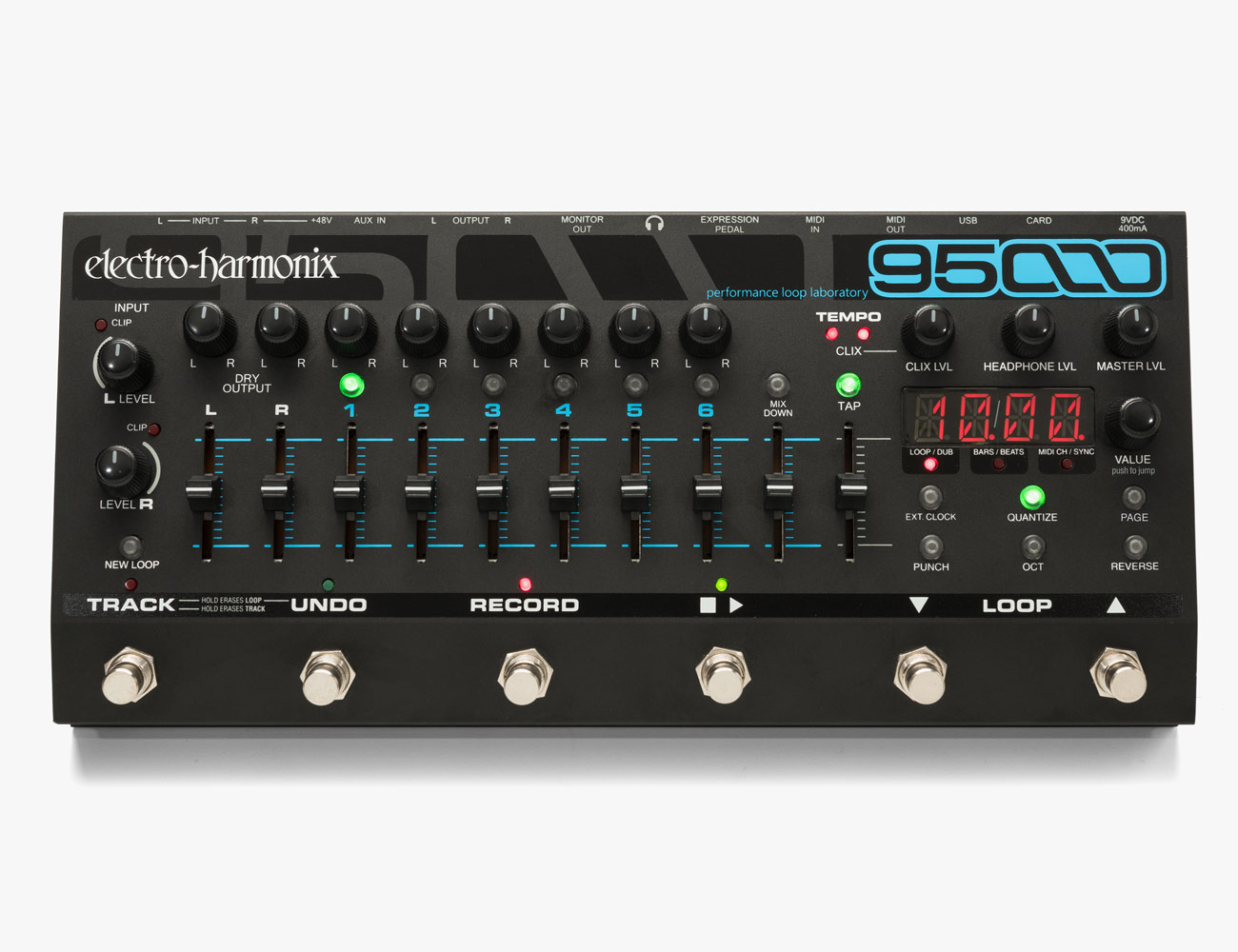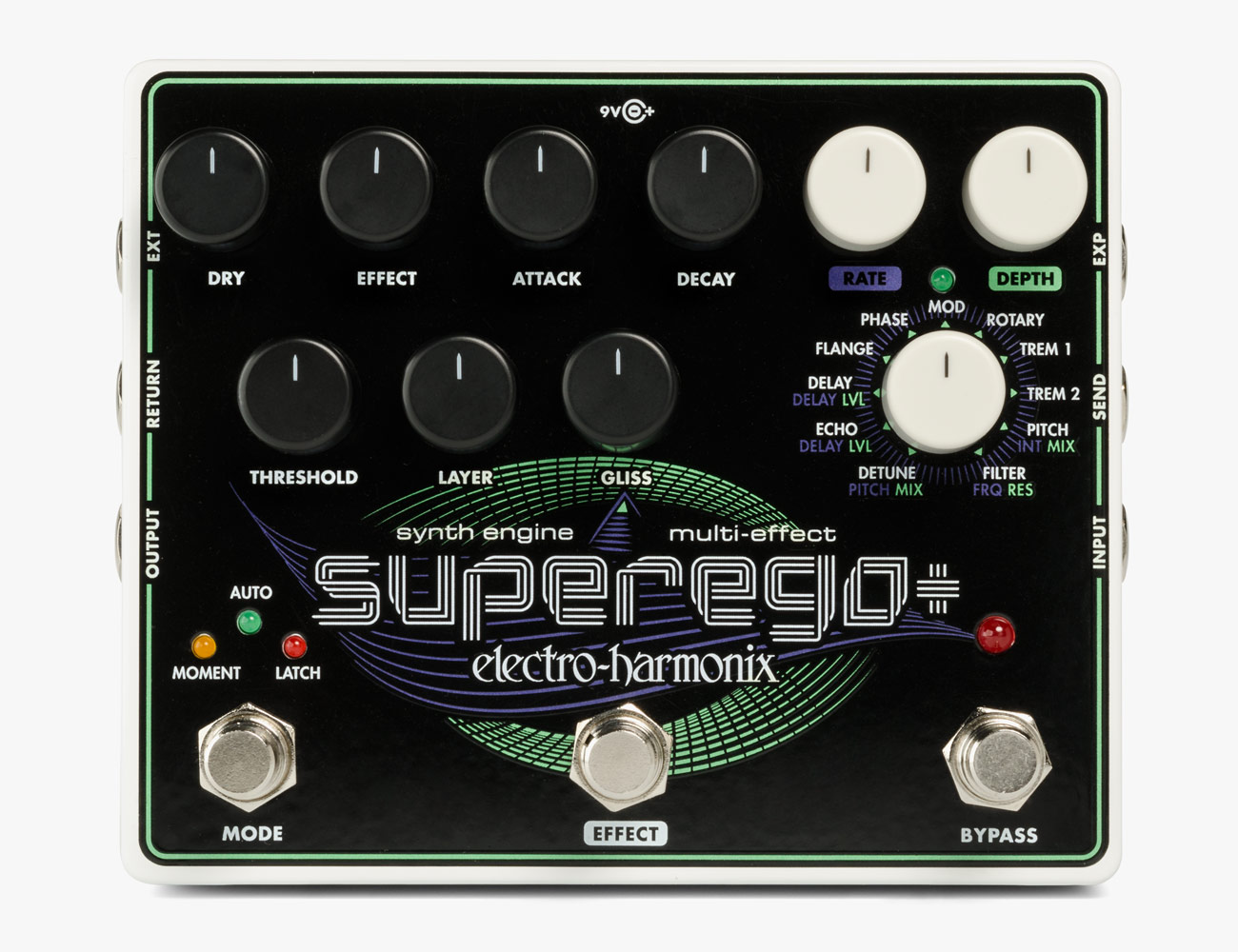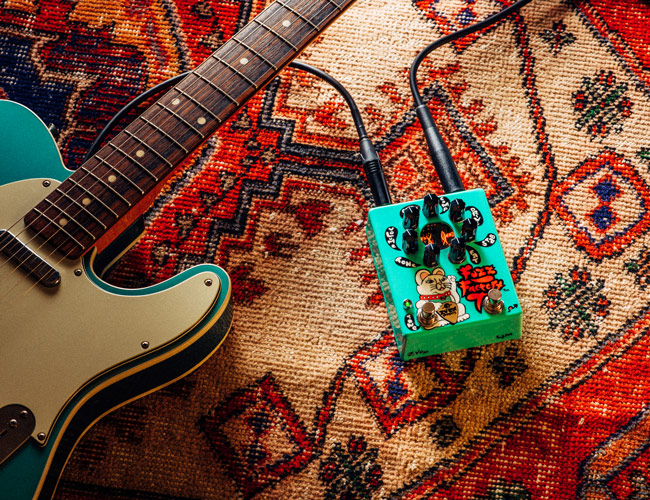T
he New York-based brand Electro Harmonix is a pioneering force in the world of effects pedals. Founded in 1968 by Mike Matthews, the company has released countless products that helped shape the sound of popular music in the latter half of the 20th century. The brand’s most popular product, a fuzz pedal called the Big Muff, was played by artists like Jimi Hendrix, David Gilmour and members of bands like the Smashing Pumpkins, Sonic Youth, Dinosaur Jr. and Mogwai. Electro Harmonix’s other pedals are equally respected and consistently found on professional musician’s boards across genres.
Today, Matthews, 76, continues to push the boundaries of pedal design. The company’s latest release, the 95000 Performance Loop Laboratory ($550), was awarded Best in Show at the 2018 National Association of Music Merchants trade show. The rugged aluminum-body pedal can record up to 375 minutes and 100 loops, and has a range of features including two-octave speed adjustment, overdubbing and reverse playback, among others. This pedal unlocks a wealth of creative potential for live looping performances and its ability to build complex arrangements is ideal for everyone from vocalists to electronic artists to acoustic musicians (see Reggie Watts demo it here).
Though Electro Harmonix is a half-century old, it remains one of the most important brands in electric music. To put the brand’s latest release in perspective, we caught up with Matthews who shared the story behind his brand, memories of Jimi Hendrix and his favorite pedals.
Q:
Electro Harmonix has always been very innovative. What led to the 95000 Looper?
A:
I founded Electro Harmonix back in 1968. In those days there were only like three companies that made pedals — now there are thousands. We were always known for being first for a lot of things. For example, we were first to introduce a product that gave overdrive to amps. Back in those days, you’d turn an amp up to 10 and it would be clean. That product was the LPB-1 Power Booster, which we fell upon by accident. We were the first company to bring out a flanger pedal, [the Electric Mistress pedal]. In those days, all of the flanging was done by rocking the tapes in the studios.
And later, we were first with analog delays with echoes: our Memory Man series. Also, we were the first digital delay pedal. In those days, the only digital delays were the expensive Lexicon rack-mount studio units. And with that, we had a long delay which was two seconds which is really a long time. So when we came out with that with the long delay, I started thinking, “Wow, I wonder what would happen if you could stretch this out to 16 seconds.” With the technology at that time, we could go to 16 seconds but the frequency response was pretty low (down to about 1000 cycles), but with the shorter delays of about eight seconds, it was about 2500/3000 cycles. That was so long, you could play something and then it would play again — so that led to the first looper, the 16 Second Digital Delay.

Electro Harmonix Founder Mike Matthews
At that time the company went belly up in ‘84. I was bankrupt, but then I got involved in vacuum tubes from Russia. While I was building up the vacuum tube business, I noticed that all the pedals I sold in the ‘70s were selling for much more money than they were in the ‘70s — and we built a lot of pedals, hundreds-of-thousands of them. So this new vintage market developed.
At the same time — it was the very early ‘90s — the Soviet Union collapsed. Everything in Russia was a military factory, and so I hooked up with a small military factory in St. Petersburg that made test equipment. I just gave them the circuit diagram of the Big Muff, which we brought out in 1969. So, they made the Big Muff and made it with Russian parts and built a big box and used Russian transistors. At first, I called it the Red Army Overdrive because it took me a while to get my trademark back, and it had a slightly different sound than the original Big Muff which a lot of people preferred, especially on bass. Eventually, we brought out two more products that were made in Russia. Then I started to re-issue a lot of stuff, and come out with a lot of new gear built in New York.
Again, we came out with a lot of innovated pedals, but one of them was our POG series which could take polyphonic notes — chords and stuff — and move it up an octave, move it up two octaves, put it down one or two octaves. You could take a guitar and make it sound like a bass guitar or add high harmonics to it. And then we came out with the HOG, which instead of octaves could add thirds and fifths. Nobody’s been able to copy our technology, so we still dominate that. During that time, a lot of other companies came out with loopers, so I was determined to get back and get our rightful share of the market. So we brought out a number of inexpensive loopers — our 360 and our 720 — and more recently, we came out with the top-of-the-line 95000 looper which is six tracks plus a seventh mix-down track. It has a lot of features and MIDI, and you can gang them together. It has built-in drum sounds or you can attach a drum machine to it. Just recently, Justin Timberlake’s tech called us up and said he wanted one to use on his current tour. And now, we’re working on still more advanced ones for the future.

Q:
You must have interacted with a lot of legendary musicians.
A:
I used to promote a lot of rock and roll shows, and I hung out and became best friends with Jimi Hendrix back when he was Jimmy James. In those days I was working for IBM selling computers and I used to go up to his hotel room — he had a narrow hotel room with no toilet — and he’d have his hair set in pink hair curlers and we’d just talk band-talk.
When he went to England, his whole style changed. But whenever he’d come to New York and record in New York, he’d invite me down to his recording sessions, and I dug the way he recorded. Most groups would make a song — practice it and practice it and practice it — and then go into the studio and cut it. If something was fucked up, they’d redo it. And after a while, they’d keep redoing things and by the time they’d get it perfect, it lost some natural groove.
What Jimi would do: he would go into the studio and have his sidemen — his drummer and bass player — just jam. When he felt it, he’d start jamming with them, and then when he felt the groove, he would just turn around and signal the recording engineer to record. And then he would just come up with something dynamite, and that was it — real natural. That’s one of the secrets, aside from his innovative playing, to all the soul that’s in his recordings.
Q:
From selling computers for IBM to starting Electro Harmonix, what inspired your career path?
A:
I’ve always been into business, ever since I was five years old. I grew up in the Bronx fishing balls out of sewers and selling them. I bought a load of lenses and prisms from a guy that made binoculars for World War II and was selling those in junior high school. It was a big fad that guys would have a prism hidden, and there’d be flashes of rainbows all over the classrooms. When I went to camp, kids would go out to play golf and I’d be out in the ponds or in the woods looking for golf balls to sell. I’d sneak out during lunch break to dive in the lake and get the fishing lures that were snagged in the rocks and sell those.
As far as music was concerned, my mother started teaching me piano when I was five and then when I was six or seven she got me formal classical lessons. I used to give concerts in elementary school, but I was a rambunctious kid. I was scheduled to do a concert in the fourth grade and I was climbing up the rafters in the classroom, and the teacher, to punish me, canceled my concert. So I said, “Fuck it,” and quit playing. But then rock and roll was becoming popular and in high school, I started playing around with boogie-woogie and piano. When I went to college — I went to Cornell — I was studying electrical engineering, not because I had any desire to become an electrical engineer, but because my father said I had to get a profession. So I just picked electrical engineering because I did well in high school in physics.
When I went to Cornell, I saw my first rock and roll band live. After that, I got a Wurlitzer electric piano and then a Hammond organ, and then I started playing that style. I was promoting all these rock and roll shows, and I was a real good player back in the early ‘60s. When I promoted groups like the Isley Brothers — that was my style — they would just travel with their guitar player, and the promoter would put together the band. So, I played and had a great bass player and a really dynamite drummer. After the gig, they begged me to quit college and go on the road with them. But in those days, this is around ‘62 or ‘63, I always knew I was going to go into business.

The Big Muff
Q:
As you mentioned, a lot has changed in the pedal space since you started the company. Would you say that it’s a natural expansion or a renaissance?
A:
Well actually, the musical instrument business as a whole is declining because there are less kids that want to be rock and roll stars now. They’re getting into video games and iPhones and all sorts of other new shit. But pedals is one area where you can really do new stuff, so the pedal business itself is growing. But of course, there are thousands of competitors. And still, you can’t bring out new products unless you have more great designers, and you can’t have designers unless you pay them, and you can’t pay them unless you make money. So it’s still basically a business.
I run things now much more conservatively and I have a balanced approach. When we’re designing new products we always have a mix of some simple new analog products, some complex analog ones, some simple digital, and we’re always working on something innovative and new, but nothing that’s going to take more than a year to bring out. Once we decide on what’s going to be in the product and start designing it, we stick with that. If we have some good new ideas, we save that for a follow-up product.

The Superego+
Q:
What product that you put out are you the proudest of?
A:
I’m most proud of what sells. So, I’m proud of the Big Muff. We’ve reissued the Green Russia Big Muff, and we also had a Big Muff version that I didn’t like that used an op-amp as opposed to four transistors. It turned out that Billy Corgan of the Smashing Pumpkins got one of those and that’s what he used on all of his recordings. He volunteered to do a demo for me of it, so we’re selling tons of those. I’m proud of our POG series and I’m proud of our advancement back again with loopers. Our Soul Food is a great overdrive pedal that we sell tons of and our Canyon Delay — it has 11 different types of delay — that’s a big hit for us now too.
Q:
Were there any designs you released that you didn’t expect to become popular?
A:
Our recent Superego+, which derived from the Superego, which derived from the Freeze which is a subset of our HOG2. The Superego+ is an expensive product. It has a lot of great new features, and I was surprised at the volume of that. Also, we’re doing great with our Cock Fight Plus which is a deluxe wah-wah pedal that’s very inexpensive, very lightweight, and not only has the best wah-wah sound, but it also has vocal sounds.
The pedal industry is in a renaissance now, and there are countless options for great fuzz pedals. Here are the best five. Read the Story





